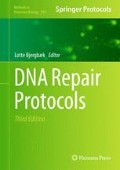Abstract
Chromosomal double strand breaks (DSBs) can be repaired by a number of mechanisms that result in diverse genetic outcomes. To examine distinct outcomes of chromosomal DSB repair, a panel of human cell lines has been developed that contain GFP-based reporters with recognition sites for the rare-cutting endonuclease I-SceI. One set of reporters is used to measure DSB repair events that require access to homology: homology-directed repair, homology-directed repair that requires the removal of a nonhomologous insertion, single strand annealing, and alternative end joining. An additional reporter (EJ5-GFP) is used to measure end joining (EJ) between distal DSB ends of two tandem I-SceI sites. These Distal-EJ events do not require access to homology, and thus are distinct from the repair events described above. Indeed, this assay provides a measure of DSB end protection during EJ, via physical analysis of Distal-EJ products to determine the frequency of I-SceI-restoration. The EJ5-GFP reporter can also be adapted to examine EJ of non-cohesive DSB ends, using co-expression of I-SceI with a non-processive 3′ exonuclease (Trex2), which can cause partial degradation of the 4 nucleotide 3′ cohesive overhangs generated by I-SceI. Such co-expression of I-SceI and Trex2 leads to measurable I-SceI-resistant EJ products that use proximal DSB ends (Proximal-EJ), as well as distal DSB ends (Distal-EJ). Therefore, this co-expression approach can be used to examine the relative frequency of Proximal-EJ versus Distal-EJ, and hence provide a measure of the fidelity of end utilization during repair of multiple DSBs. In this report, the repair outcomes examined by each reporter are described, along with methods for cell culture, transient expression of I-SceI and Trex2, and repair product analysis.
Access this chapter
Tax calculation will be finalised at checkout
Purchases are for personal use only
References
Wyman C, Kanaar R (2006) DNA double-strand break repair: all’s well that ends well. Annu Rev Genet 40:363–383
Bennardo N, Cheng A, Huang N, Stark JM (2008) Alternative-NHEJ is a mechanistically distinct pathway of mammalian chromosome break repair. PLoS Genet 4:e1000110
Bennardo N, Gunn A, Cheng A, Hasty P, Stark JM (2009) Limiting the persistence of a chromosome break diminishes its mutagenic potential. PLoS Genet 5:e1000683
Moure CM, Gimble FS, Quiocho FA (2003) The crystal structure of the gene targeting homing endonuclease I-SceI reveals the origins of its target site specificity. J Mol Biol 334:685–695
Pierce AJ, Johnson RD, Thompson LH, Jasin M (1999) XRCC3 promotes homology-directed repair of DNA damage in mammalian cells. Genes Dev 13:2633–2638
Stark JM, Pierce AJ, Oh J, Pastink A, Jasin M (2004) Genetic steps of mammalian homologous repair with distinct mutagenic consequences. Mol Cell Biol 24:9305–9316
Stark JM, Jasin M (2003) Extensive loss of heterozygosity is suppressed during homologous repair of chromosomal breaks. Mol Cell Biol 23:733–743
Johnson RD, Jasin M (2000) Sister chromatid gene conversion is a prominent double-strand break repair pathway in mammalian cells. EMBO J 19:3398–3407
Stark JM, Hu P, Pierce AJ, Moynahan ME, Ellis N, Jasin M (2002) ATP hydrolysis by mammalian RAD51 has a key role during homology-directed DNA repair. J Biol Chem 277:20185–20194
Guirouilh-Barbat J, Huck S, Bertrand P, Pirzio L, Desmaze C, Sabatier L, Lopez BS (2004) Impact of the KU80 pathway on NHEJ-induced genome rearrangements in mammalian cells. Mol Cell 14:611–623
Guirouilh-Barbat J, Rass E, Plo I, Bertrand P, Lopez BS (2007) Defects in XRCC4 and KU80 differentially affect the joining of distal nonhomologous ends. Proc Natl Acad Sci U S A 104:20902–20907
Lieber MR (2010) The mechanism of double-strand DNA break repair by the nonhomologous DNA end-joining pathway. Annu Rev Biochem 79:181–211
Sartori AA, Lukas C, Coates J, Mistrik M, Fu S, Bartek J, Baer R, Lukas J, Jackson SP (2007) Human CtIP promotes DNA end resection. Nature 450:509–514
Stracker TH, Petrini JH (2011) The MRE11 complex: starting from the ends. Nat Rev Mol Cell Biol 12:90–103
Yang Y-G, Saidi A, Frappart P-O, Min W, Barrucand C, Dumon-Jones V, Michelon J, Herceg Z, Wang Z-Q (2006) Conditional deletion of Nbs1 in murine cells reveals its role in branching repair pathways of DNA double-strand breaks. EMBO J 25:5527–5538
Iliakis G, Rosidi B, Wang M, Wang H (2006) Plasmid-based assays for DNA end-joining in vitro. Methods Mol Biol 314:123–131
Bennardo N, Stark JM (2010) ATM limits incorrect end utilization during non-homologous end joining of multiple chromosome breaks. PLoS Genet 6:e1001194
Chen M-J, Ma S-M, Dumitrache LC, Hasty P (2007) Biochemical and cellular characteristics of the 3′ → 5′ exonuclease TREX2. Nucleic Acids Res 35:2682–2694
Perrino FW, Harvey S, McMillin S, Hollis T (2005) The human TREX2 3′ → 5′-exonuclease structure suggests a mechanism for efficient nonprocessive DNA catalysis. J Biol Chem 280:15212–15218
Nakanishi K, Yang YG, Pierce AJ, Taniguchi T, Digweed M, D’Andrea AD, Wang ZQ, Jasin M (2005) Human Fanconi anemia monoubiquitination pathway promotes homologous DNA repair. Proc Natl Acad Sci U S A 102:1110–1115
Acknowledgements
This work was supported by NIH grant RO1CA120954 to J.M.S. Thanks to Nicole Bennardo, Meilen Muñoz, and Anita Cheng for technical contributions.
Author information
Authors and Affiliations
Corresponding author
Editor information
Editors and Affiliations
Rights and permissions
Copyright information
© 2012 Springer Science+Business Media New York
About this protocol
Cite this protocol
Gunn, A., Stark, J.M. (2012). I-SceI-Based Assays to Examine Distinct Repair Outcomes of Mammalian Chromosomal Double Strand Breaks. In: Bjergbæk, L. (eds) DNA Repair Protocols. Methods in Molecular Biology, vol 920. Humana Press, Totowa, NJ. https://doi.org/10.1007/978-1-61779-998-3_27
Download citation
DOI: https://doi.org/10.1007/978-1-61779-998-3_27
Published:
Publisher Name: Humana Press, Totowa, NJ
Print ISBN: 978-1-61779-997-6
Online ISBN: 978-1-61779-998-3
eBook Packages: Springer Protocols

